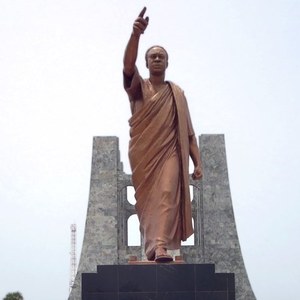by Gifty Etornam Katahena – continued from #16
A further Classical echo is in a portrait of Kwame Nkrumah, the first President of the Republic of Ghana, situated at his Mausoleum in Kwame Nkrumah Memorial Park, Accra. To those who understand the reference, this reminds us of a statue of Augustus, first emperor of Rome, the so-called Prima Porta statue from the Villa of Livia Drusilla at Prima Porta, near Rome. The statue is now in the Braccio Nuovo of the Vatican Museums.

Ancient societies used art for propagandistic purposes and images created were used to communicate messages, including what they stood for and what agenda they were promoting. Roman art was closely intertwined with politics and propaganda. The statue of Augustus is not simply a portrait of the emperor; he used the power of imagery to communicate his ideology – from his apparel to his posture. The portrait expresses Augustus’ connection to the past and to the gods, his role as a military victor, and as the bringer of the Roman Peace. It is likely that Kwame Nkrumah harnessed this same power of imagery to communicate his ideology. Dressed this way, the statue connects with the indigenous people by wearing the toga-like clothing which is the traditional outfit discussed and illustrated earlier. His role as victor (gaining independence from British rule and dominance), and his outstretched right hand symbolise progression or advancement. Arguably, this is not coincidental, but potentially an adaptation or recreation of Augustus’ Prima Porta image, or Roman statues before his, for a communicative purpose.

Other classical comparisons might be seen in town planning. At the centre of the city of Accra (the capital town of Ghana) is a well thought out layout that fits the description of an ancient Greek agora. The agora was the center of the athletic, artistic, business, social, religious, and political life in the city. Accra Central is largely designed for commercial purposes. However, it also represents the athletic, artistic, social, religious, and political life in the city. One can cite the Supreme Court, the Law School, as well as basic/elementary, junior and senior secondary schools, temples of various religious denominations, the Legislative Chamber (Parliament), the Accra Sports Stadium, the Bank of Ghana, the National Theatre, at the heart of the city. Also a coincidence? Or a well thought out plan to have everything at the city centre just like the ancient Greek agora?
As a budding Classicist interested in the relevance of Classics to the Ghanaian, thereafter, its reception, coincidences are rare especially when semblances aforementioned do not exist as conscious creations but as models. Like democracy, some ideas of the ancient Greeks and Romans were instilled, taught, and experimented with during British rule. After the British left the shores of Ghana, not all these ancient ideas were abandoned. Most of these ideas have been adapted and remodelled to fit the Ghanaian culture, practices, and general outlook. Sophocles’ Antigone has been adapted as Odale’s Choice to re-narrate the ancient story in a Ghanaian way. Euripides’ Alcestis has also been adapted in a Ghanaian way for the Ghanaian stage as Edufa. Euripides’ Medea has been translated into twi (one of the Ghanaian languages) for accessibility. Reception might mean different things to people in different continents and countries. That notwithstanding, it is an underlying fact that Reception encompasses examining our own contemporary societies and the ancient societies, comparatively or as encounters in human experience(s). In Ghana, reception of the Classics (Greek and Roman legacies) is the thriving force of the study of Classics. It is probably the only reason why it is still part of the University’s curricula. Students generally want to be able to relate to the human development of the ancient Greeks and Romans politically, socially, culturally, and perhaps, religiously. The similarities in cultures or cultural practices may not account for what constitutes reception of the classics but it is worth discussing to illuminate cultural semblance of people in different epochs and continents as part of studying and understanding human nature.


Great piece. Very Educative and Insightful
“The similarities in cultures or cultural practices may not account for what constitutes reception of the classics but it is worth discussing to illuminate cultural semblance of people in different epochs and continents as part of studying and understanding human nature.” I couldn’t agree more. Excellent piece.